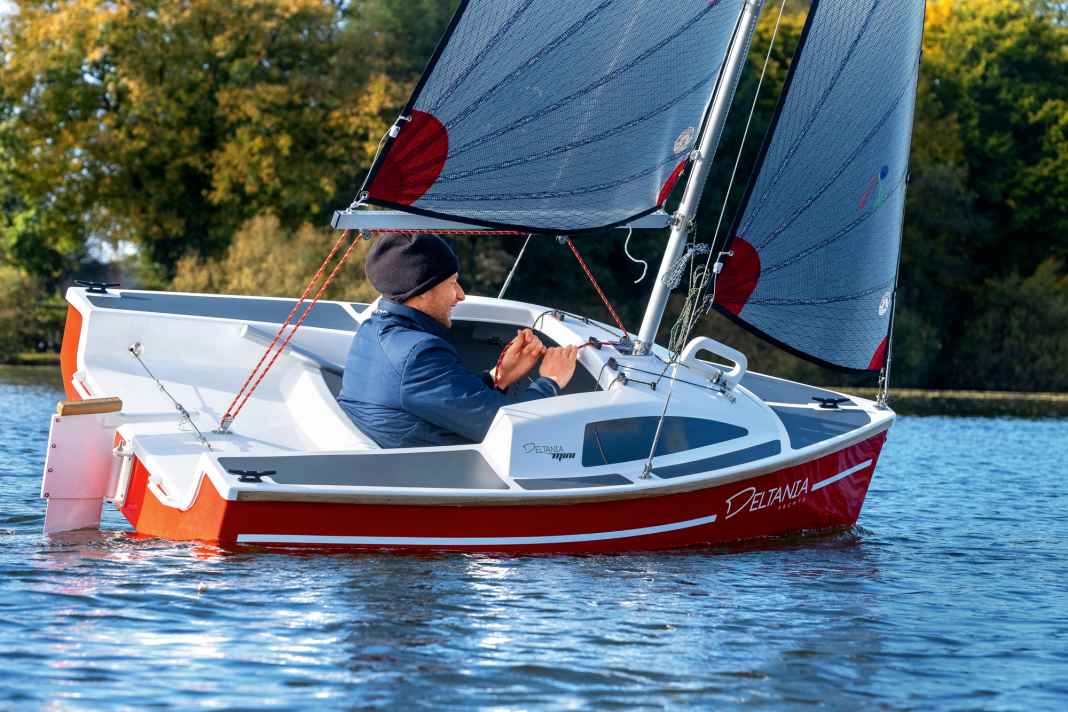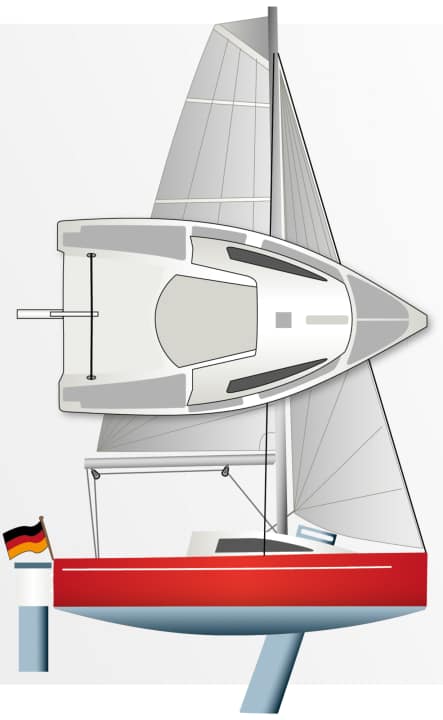





Small boats offer many advantages. On the Deltania Mini, for example, the halyards on the mast can easily be lowered while sitting in the cockpit. There's no need to deflect the line aft. The sailor is well protected by the superstructure, sitting both in the companionway and the saloon, with his feet in the foredeck. He doesn't need winches either, as the sail areas of the genoa and mainsail are roughly the size of a duvet. The loads are therefore manageable. This has further advantages: lower costs, quick changes of sailing area and favourable winter storage in the cellar or shed at home.
Read more about small sailors:
But the Deltania Mini is special because it doesn't really want to fit into an existing category. It shares some characteristics with dinghies: The weight is very low, so the displacement more than doubles with crew. There is also no keel. Visually, however, there are some arguments against categorising it as a dinghy. The Deltania is not open, but has a superstructure. That's why it looks like a small cruiser at first glance. Without the size comparison with a person, it could be mistaken for a much larger boat. The Deltania Mini can therefore pass for a yacht, just shrunk down to a super-small size.
Mini-sailors on a mini sea
But what is so special about the Deltania Mini? We made an appointment with Pascal Ernst, the owner of Neptun-Yachten, to find out. The Deltania Mini is his idea. The sailing area, Lake Lintel, suits the boat perfectly - it's tiny. Located right next to the Autobahn 2 motorway near Rheda-Wiedenbrück, it is around 450 metres long and 300 metres wide.
Plenty of space for our test boat. A light breeze is blowing, with occasional gusts of up to ten knots of wind rippling the water. The boat is rigged in a few simple steps and the sails are hoisted. Then it's off into the water via the slip ramp. However, getting into the Deltania proves to be more difficult than expected. You have to take a big step over the running deck without losing your balance. It is better to get on from a jetty, but this was not an option during the test. So off we went into the boat on the central seat in the middle of the companionway and the last few metres into the water with the slip trolley. After a few squiggles, the foresail stood up by itself on the raised centreboard, then paddling against it, which was not easy to do with a paddle and due to the deck structure.
which was not easy to manage with a paddle and the deck structure. Two one-handed paddles would certainly be more helpful here, so that manoeuvring could be more targeted. However, there is also an optional pod drive for SUPs from Epropulsion.
Under sail
A few curls later, the depth of the water allows the centreboard and rudder blade to be lowered. With a little wind in the sails, we head out onto the lake. After a few moments, the steering is intuitively understood. Instead of using a tiller, the Deltania Mini is steered using a joystick below deck, i.e. between the knees. If the joystick is tilted to port, the bow also steers in the same direction. This is very direct, even slight movements are sufficient. However, there is not much feedback from the rudder blade. You have to look closely at the sails. Unusual: they are directly in front of or above you in the wind.



The first small gust creates a situation where the occupant instinctively wants to move his weight to windward, but this is prevented by the companionway on the shoulder. You can't sit on the edge, you would have to sit on the aft deck, which is not compatible with the fore-and-aft trim, and the joystick is then out of reach. Even if there is little room for weight shifting to windward, it does make a difference. The difference becomes clear when you lean to leeward. The water then splashes a little on the running decks (the deck covering is for the ship-like appearance, there is no running here), but as soon as the chine is in the water, the Deltania does not tip any further.
However, there was only a very light breeze on the test day. In stronger winds, it would certainly be advisable to upgrade to the optional ballast centreboard (twelve kilograms, 850 euros) and, in even stronger winds, the so-called storm sail (mainsail and headsail, 430 euros). There was no risk of capsizing in the test, but this scenario is certainly possible with the Deltania Mini. To prevent the miniature yacht from sinking, the options list also includes a 60-litre buoyancy chamber.
Good operability due to short distances
Because the small Deltania reacts directly to every breath of wind and picks up speed noticeably, the steering is very direct and the water surface is close, the boat speed is extremely misjudged. The Deltania feels faster than a glance at the smartphone reveals: On the wind it is just under two knots, at half wind just under three. In small gusts, it can even reach 3.5 knots, which means that the calculated hull speed is almost exhausted.
It sits comfortably, the seat is 50 centimetres wide at the back and tapers to 40 centimetres at the front. The backrest is 38 centimetres high and the body roof is 58 centimetres above the seat. This means you can easily see over it and the clamps are right in front of you. There is a cleat for the foresheet on the very outside, the mainsheet cleat is positioned in the centre and the line for hauling up the centreboard is slightly to the right.
Footrests are still possible below deck; the shipyard has already provided the reinforcements for them in the side wall. However, they are not absolutely necessary. It sits well as it is. The Deltania Mini is fun, even if not much speed can be expected and despite the limited freedom of movement. In fact, the small boat is already a bestseller, with 70 units already sold.
The price of the Deltania Mini is sensational
Pascal Ernst was initially surprised by this himself, as the Deltania Mini was originally only intended as an exhibition piece, as an easily transportable model for trade fairs. The project then took on a life of its own and the interest in actually taking the nanocruiser out on the water was enormous. This is certainly also due to the price. For 4,999 euros, the Deltania Mini is a ready-to-sail boat. It also fits easily into a van or even a station wagon. In terms of price, the little boat is even just under the new price of a regatta dinghy.
- Base price ex shipyard: 4.999 €
- Guarantee/against osmosis: 2/5 years
- Slip carriage: 425 €
- Regatta sailing: 850 €
- Storm sails: 430 €
- Ballast sword: 850 €
- Buoyancy chamber 60 litres: 350 €
- Tarpaulin: 350 €
As of 02/2025, how the prices shown are defined, read here!
The comparison with the Optimist is obvious because the dimensions are almost identical. The Deltania is only seven centimetres wider, weighs almost as much, but has half a square metre less sail area. As the hull narrows towards the waterline, the Deltania is significantly more slender than the box-shaped Optimist. However, the price is almost the same, it is also fun - and curious glances are guaranteed.
The Deltania Mini in detail

Technical data of the Deltania Mini
- CE design category: k.A.
- Torso length: 2,30 m
- Waterline length: 2,21 m
- Width: 1,20 m
- Draught/catch-up: 0,80/0,15 m
- Mast height above WL: 3,00 m
- Theor. torso speed: 3.6 kn
- Torso weight: 35.0 kg
- Total weight: 50.0 kg
- Ballast sword/ballast: 12.0 kg/24 %
- Sword: 4.5 kg
- Mainsail: 2,08 m²
- Foresail: 0,98 m²
- Storm sails: 1,60 m²
Hull and deck construction
Full laminates, manufactured by hand, with ISO-NPG-based polyester resin. This should minimise problems with osmosis.
CE design category
The Deltania Mini is too small for CE categorisation, which is only mandatory from a hull length of 2.50 metres.
Construction & processing
The seat is part of the deck and connected to the hull. It thus provides stability almost like an inner shell. The centreboard box also acts as a stiffener for the mast foot due to the fixed connection between the hull and deck. The deck hull connection is concealed behind the rubbing strake. The gelcoat surfaces are flawless. The hull is available in the colour of your choice for an extra charge (250 euros).
Layout
There is only one seating position in the companionway, so weight trimming is very limited. The feet can be extended into the bow. The joystick is particularly noteworthy. Halyards, outhaul and sheets can be reached from the seat.
Sailing performance & rig
The mast, which is less than three metres long, does not require spreaders or backstay and can therefore be set very quickly. The hull speed can be reached even with very little wind.
Shipyard and distribution
Deltania Yachts (Neptun-Yachts), Dieselstraße 8, Rheda-Wiedenbrück; www.deltania-yachts.de

